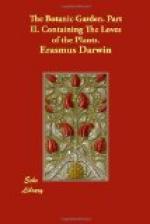These vegetable monsters are formed in many ways. 1st. By the multiplication of the petals and the exclusion of the nectaries, as in larkspur. 2d. By the multiplication of the nectaries and exclusion of the petals; as in columbine. 3d. In some flowers growing in cymes, the wheel-shape flowers in the margin are multiplied to the exclusion of the bell-shape flowers in the centre; as in gelder-rose. 4th. By the elongation of the florets in the centre. Instances of both these are found in daisy and feverfew; for other kinds of vegetable monsters, see Plantago.
The perianth is not changed in double flowers, hence the genus or family may be often discovered by the calyx, as in Hepatica, Ranunculus, Alcea. In those flowers, which have many petals, the lowest series of the petals remains unchanged in respect to number; hence the natural number of the petals is easily discovered. As in poppies, roses, and Nigella, or devil in a bulb. Phil. Bot. p. 128.]
[Iris. l. 71. Flower de Luce. Three males, one female. Some of the species have a beautifully freckled flower; the large stigma or head of the female covers the three males, counterfeiting a petal with its divisions.]
[Cupressus. l. 73. Cypress. One House. The males live in separate flowers, but on the same plant. The males of some of these plants, which are in separate flowers from the females, have an elastic membrane; which disperses their dust to a considerable distance, when the anthers burst open. This dust, on a fine day, may often be seen like a cloud hanging round the common nettle. The males and females of all the cone-bearing plants are in separate flowers, either on the same or on different plants; they produce resins, and many of them are supposed to supply the most durable timber: what is called Venice-turpentine is obtained from the larch by wounding the bark about two feet from the ground, and catching it as it exsudes; Sandarach is procured from common juniper; and Incense from a juniper with yellow fruit. The unperishable chests, which contain the Egyptian mummies, were of Cypress; and the Cedar, with which black-lead pencils are covered, is not liable to be eaten by worms. See Miln’s Bot. Dict. art. coniferae. The gates of St. Peter’s church at Rome, which had lasted from the time of Constantine to that of Pope Eugene the fourth, that is to say eleven hundred years, were of Cypress, and had in that time suffered no decay. According to Thucydides, the Athenians buried the bodies of their heroes in coffins of Cypress, as being not subject to decay. A similar durability has also been ascribed to Cedar. Thus Horace,
_——speramus
carmina fingi
Posse
linenda cedre, & lavi servanda cupresso._
[Osyris. l. 75. Two houses. The males and females are on different plants. There are many instances on record, where female plants have been impregnated at very great distance from their male; the dust discharged from the anthers is very light, small, and copious, so that it may spread very wide in the atmosphere, and be carried to the distant pistils, without the supposition of any particular attraction; these plants resemble some insects, as the ants, and cochineal insect, of which the males have wings, but not the female.]




